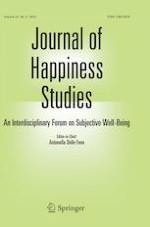26-06-2023 | Research Paper
Mindfulness and Subjective Well-being Among Chinese Adolescents: A Longitudinal Study and a Weekly Diary Investigation
Published in: Journal of Happiness Studies | Issue 6/2023
Log inActivate our intelligent search to find suitable subject content or patents.
Select sections of text to find matching patents with Artificial Intelligence. powered by
Select sections of text to find additional relevant content using AI-assisted search. powered by
